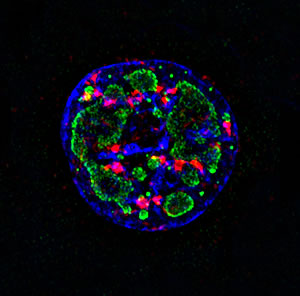
February 9, 2011
LA JOLLA, CA—The Waitt Advanced Biophotonics Center at the Salk Institute for Biological Studies officially opens on February 9, 2011 after quietly hiring two faculty members specializing in biophotonics—the science of using and manipulating light to investigate biological function—and building up its core facility’s imaging capacity to rival most if not all academic research institutions of its size in the nation.
Launched with a landmark $20 million gift from the Waitt Foundation, the Waitt Advanced Biophotonics Center serves as a state-of-the-art research hub, driving the development of next-generation imaging and visualization tools and enabling investigators from across many biological disciplines to take advantage of the latest imaging technology.
“By putting these incredible tools in the hands of Salk investigators in an interdisciplinary teamwork environment, breakthroughs are bound to happen,” said Ted Waitt, vice-chair of the Salk Institute board of trustees and chairman of the Waitt Foundation
“Imaging, and the visualization of images, are pervasive elements in our data-rich day-to-day lives, but even more so in biomedical research,” said Salk president William R. Brody, M.D., Ph.D. “Having access to the latest imaging technology will have tremendous impact on our ability to visualize the inner dynamics of single cells, to understand the physiology of human disease and find new ways to treat it.”
The faculty research labs housed within the Waitt Advanced Biophotonics Center are engaged in both imaging technology development and answering fundamental problems in the life sciences.

State-of-the-art imaging technology revealed that the tiny adenovirus protein known as ORF3 (shown in red) clears the way for adenovirus replication (shown in green) by creating “zip files” of genes (shown in blue) that help the cell defend itself against the virus.
Image: Courtesy of Dr. Horng Ou in the Laboratory of Dr. Clodagh O’Shea and Dr. James Fitzpatrick, Waitt Advanced Biophotonics Center
“Biophotonics is one of those transforming technologies that will impact nearly all the science being done at the Salk Institute,” said Inder Verma, Ph.D., an American Cancer Society professor in the Laboratory of Genetics and holder of the Irwin and Joan Jacobs Chair in Exemplary Life Science.
Axel Nimmerjahn, Ph.D., an assistant professor in the Waitt Advanced Biophotonics Center and holder of the Richard Allan Barry Developmental chair, joined the Salk Institute from Stanford University in November of last year.
His laboratory focuses on the innovation of light microscopic tools that will enable novel studies of enigmatic brain cells called glia. Long thought to be nothing more than support cells, glia have emerged as sophisticated cellular players that make crucial contributions to normal brain physiology and pathology. Glioma, amyotrophic lateral sclerosis, Alexander’s disease and stroke are just a few examples of diseases glia are critically involved in. Nimmerjahn has created and continues to develop tools that allow researchers to directly visualize and manipulate glia in the intact healthy and diseased brain. This has led to key insights in glial cell biology, with broad implications for our view of brain function, which may eventually culminate in new treatments for neurodegenerative brain disease.
Also hailing from Stanford University, Björn Lillemeier, Ph.D., an assistant professor in both the Nomis Foundation Laboratories for Immunobiology and Microbial Pathogenesis and the Waitt Advanced Biophotonics Center and holder of the Rudolph and Sletten Developmental Chair, joined the Salk Institute in November 2009.
In his laboratory, he investigates the complex architecture of the plasma membrane-the double layer of lipid molecules that encloses all cells-as well as its contribution to signal transduction mechanisms in T cells, whose main job is to fight infection. Lillemeier is developing a combination of super-resolution microscopy based on photoactivation localization microscopy (PALM) with dual-color fluorescence correlation spectroscopy (dcFCS), to directly observe the spatial and temporal distribution of membrane-associated molecules on a nanometer scale. Understanding how these mechanisms become altered in diseased cells will provide routes to new therapies for autoimmune diseases and cancer.
The core facility within the Waitt Advanced Biophotonics Center enables Salk faculty to integrate cutting-edge imaging approaches into their biological research programs.
James Fitzpatrick, Ph.D., director of the Waitt Advanced Biophotonics Center Core Facility, who joined the Salk Institute from Carnegie Mellon University in December 2009, helps researchers apply both light and electron-based imaging methods to fundamental problems in the life sciences.
The core facility is equipped with some of the most cutting-edge and technically advanced imaging and microscopy instrumentation in the country. One of the key technology enablers is a Libra 120 PLUS Energy-Filtered Transmission Electron Microscope (EF-TEM) from Carl Zeiss Nanotechnology Systems. The Libra 120 PLUS system and the Biophotonics Core Facility will act as a test bed for future developments of correlative light and electron microscopy methods in collaboration with Carl Zeiss Nanotechnology Systems. Also key is the Olympus FluoView 1000 MPE Coherent Anti-Stokes Raman (CARS) microscope, which is the first commercial system of its kind to be installed in North America.
Other instrumentation available to Salk researchers includes, but is not limited to, live-cell confocal and fluorescence microscopy solutions from Carl Zeiss Microimaging, high-speed fluorescence and two-photon microscopy from Olympus America, total internal reflection microscopy (TIRFM) from Nikon Instruments and automation and cell identification technology from Metasystems International.
About the Salk Institute for Biological Studies:
The Salk Institute for Biological Studies is one of the world’s preeminent basic research institutions, where internationally renowned faculty probe fundamental life science questions in a unique, collaborative, and creative environment. Focused both on discovery and on mentoring future generations of researchers, Salk scientists make groundbreaking contributions to our understanding of cancer, aging, Alzheimer’s, diabetes and infectious diseases by studying neuroscience, genetics, cell and plant biology, and related disciplines.
Faculty achievements have been recognized with numerous honors, including Nobel Prizes and memberships in the National Academy of Sciences. Founded in 1960 by polio vaccine pioneer Jonas Salk, M.D., the Institute is an independent nonprofit organization and architectural landmark.
Office of Communications
Tel: (858) 453-4100
press@salk.edu